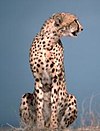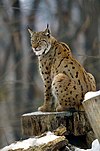List of largest cats
This list of largest cats shows 10 Felidae species, ordered by maximum reported weight and size of wild individuals on record. The list does not contain cat hybrids.
| Rank | Common name | Scientific name | Image | Weight range (kg) | Maximum weight (kg) | Maximum length (m)[a] | Maximum shoulder height (m) | Native range by continent(s) |
|---|---|---|---|---|---|---|---|---|
| 1 | Tiger | Panthera tigris |  |
90-306[1] | 400 (in the wild, unverified)[2] | 4.17[3] | 1.27 | Asia |
| 2 | Lion | Panthera leo |  |
160-225[b] | 313 (in the wild;[5][6] disputed)[7][c] | 3.64[citation needed] | 1.35 | Asia, Africa |
| 3 | Jaguar | Panthera onca |  |
56-120 | 160[8][9] | 2.6 | 1.0 | North and South America |
| 4 | Cougar | Puma concolor |  |
53-100 | 125.2[10] | 2.8[10] | 1.0 | North and South America |
| 5 | Leopard | Panthera pardus |  |
37-90 | 96.5[9] | 2.75[11][12] | 0.9 | Asia, Africa |
| 6 | Snow leopard | Panthera uncia |  |
22-55 | 75[13][14] | 2.5[13][14] | 0.75 | Asia |
| 7 | Cheetah | Acinonyx jubatus |  |
20-60 | 72[15] | 2.1[8] | 1.0 | Africa, Asia |
| 8 | Eurasian lynx | Lynx lynx |  |
38[16] | 1.5[8][17] | 0.75 | Asia, Europe | |
| 9 | Sunda clouded leopard | Neofelis diardi |  |
12-26 | 27 | 1.3 | 0.65 | Asia |
| 10 | Clouded leopard | Neofelis nebulosa |  |
11.5-23 | 23 | 1.08 | 0.7 | Asia |
See also
Wikispecies has information related to Reptilia.
- Big cat
- List of largest mammals
- List of largest land carnivorans
- Largest organisms
- Tiger versus lion
Notes
- ^ This refers to the length including the tail. Note that lengths given as "between the pegs" generally include the tail.
- ^ 186.55–225 kg (411.3–496.0 lb) in Southern Africa, 174.9 kg (386 lb) in East Africa, 160–190 kg (350–420 lb) in India[4]
- ^ The largest known lion measured 3.35 m (11.0 ft). An exceptionally heavy male lion near Mount Kenya weighed 272 kg (600 lb). The longest wild lion reportedly was a male shot near Mucusso National Park in southern Angola in 1973.
References
- ^ Mazak, Vratislav (8 May 1981). "Panthera tigris". Mammalian Species (152): 1–8. doi:10.2307/3504004.
- ^ Wood, G. L. (1983). The Guinness Book of Animal Facts and Feats. Sterling Publishing. ISBN 978-0-85112-235-9.
- ^ https://books.google.com/books?id=UxWZ-OmTqVoC&lpg
- ^ Smuts, G. L.; Robinson, G. A.; Whyte, I. J. (1980). "Comparative growth of wild male and female lions (Panthera leo)". Journal of Zoology. 190 (3): 365–373. Bibcode:2010JZoo..281..263G. doi:10.1111/j.1469-7998.1980.tb01433.x.
- ^ Wood, G. L. (1976). The Guinness Book of Animal Facts and Feats. Guinness Superlatives. ISBN 978-0-900424-60-1.
- ^ Wood, G. L. (1983). The Guinness Book of Animal Facts and Feats. Sterling Publishing. ISBN 978-0-85112-235-9.
- ^ "East African Business Digest", University Press of Africa, with contributions from the Kenya National Chamber of Commerce & Industry, 1963, retrieved 2018-03-18
- ^ a b c Nowak, Ronald M. (1999). "Carnivora, Felidae". Walker's Mammals of the World. Vol. Vol. 2. Baltimore: Johns Hopkins University Press. pp. 797–836. ISBN 0-8018-5789-9.
{{cite book}}:|volume=has extra text (help) - ^ a b Burnie, David; Wilson, Don E. (2001). Animal: The Definitive Visual Guide to the World's Wildlife. New York City: Dorling Kindersley. ISBN 0-7894-7764-5.
- ^ a b Hornocker, Maurice (2010). Cougar: Ecology and Conservation. University of Chicago Press. ISBN 978-0-2263-5344-9.
- ^ Pease, A. E. (1913). "Of dangerous game". The Book of the Lion. London: John Murray. pp. 46–68.
{{cite book}}: External link in|chapterurl=|chapterurl=ignored (|chapter-url=suggested) (help) - ^ Brain, C. K. (1983). The Hunter or the Hunted: An Introduction to African Cave Taphonomy. University of Chicago Press. ISBN 978-0-226-07090-2.
- ^ a b Boitani, Luigi (1984). Guide to Mammals. Simon & Schuster / Touchstone Books. ISBN 978-0-671-42805-1.
- ^ a b Hemmer, H. (1972). "Uncia uncia". Mammalian Species. 20 (20): 1–5. doi:10.2307/3503882. JSTOR 3503882.
- ^ Estes, R. D. (2004). The Behavior Guide to African Mammals: Including Hoofed Mammals, Carnivores, Primates (4th ed.). Berkeley: University of California Press. pp. 377–383. ISBN 978-0-520-08085-0.
- ^ "Lynx and Bobcat". SanDiegoZoo.org. San Diego Zoo Global.
- ^ Page, Amanda; Kirkpatrick, Win; Massam, Marion (January 2008). Risk Assessment for Australia – Eurasian Lynx (Lynx lynx). Government of Western Australia: Department of Agriculture and Food. pp. 1–18.
